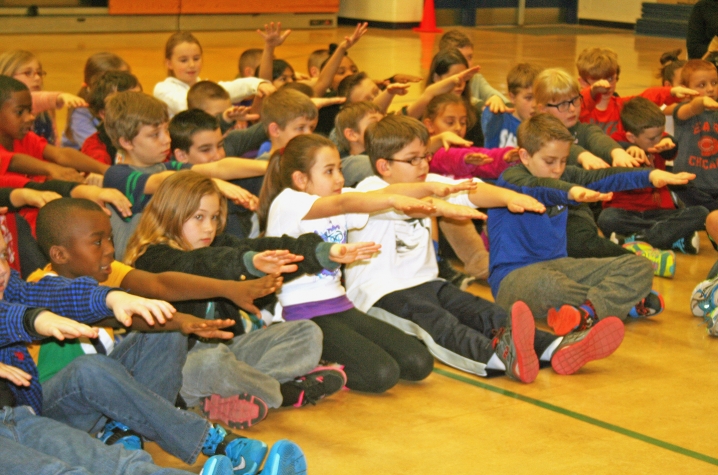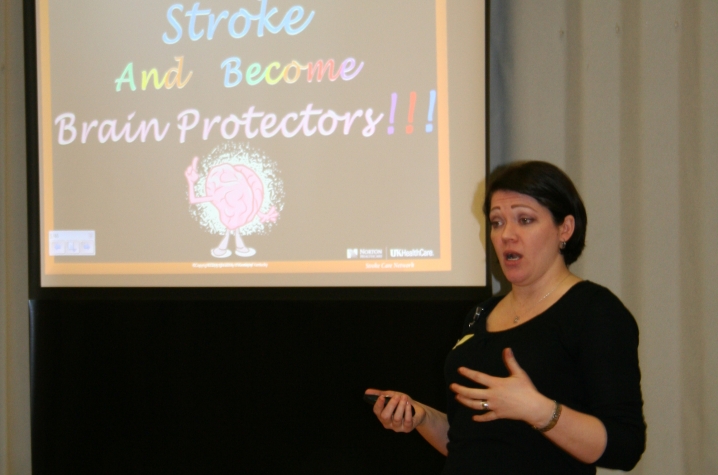Fayette County Students Learn the Value of FAST
LEXINGTON, Ky. (Feb. 13, 2015) -- Last week, fourth and fifth grade students at Athens-Chilesburg Elementary (ACE) learned how to be FAST-- not at a track meet or on the basketball court, but in a medical emergency.
Because a quick response can mitigate the effects of a stroke, it's critical to know the warning signs and get help as soon as possible, says Lisa Bellamy, director of the Stroke Care Network under the UK HealthCare/Norton Healthcare umbrella. That's why the network created SCOPE -- Stroke Community Outreach Prevention and Education Program.
“We call stroke a brain attack," says Bellamy. "Even young children can recognize stroke symptoms, and we emphasize the importance of calling 9-1-1 if they think someone is having a stroke. We want them to have a sense of urgency because once the damage happens from a stroke, it’s irreversible.”
These young students caught on quickly, she said.
“Every second, brain cells die and if too many die, your body just can’t work,” said 10-year-old Jamison Gordon, explaining what happens when blood flow to the brain is interrupted. “A stroke can easily kill you if you don’t catch it in time.”
FAST stands for Face, Arms, Speech and Time. For example, if a person’s face or smile is distorted because the muscles aren’t receiving signals from the brain, that’s a clear indication to call for help. Likewise, if the victim cannot raise one arm overhead or if their speech is garbled, it’s best to summon an ambulance. And the time factor is crucial: the sooner a stroke victim gets emergency care, the higher their chances of surviving a stroke with minimal deficits.
Stroke is the No. 1 cause of disability and the No. 5 cause of death in the United States. ACE P.E. teacher Kristi Landversicht booked SCOPE because she thought this age group could comprehend the basics. “The information is pretty easy to learn and good to know,” said Landversicht, who planned to quiz the students in their next class.
While SCOPE's colorful PowerPoint and cartoon video clips presented details in child-friendly terms, they didn’t sugarcoat the seriousness of the topic. “You can literally save a life,” Crystal Vires-Smith, SCOPE clinical associate, told students gathered in the gym.
Vires-Smith and SCOPE co-chair Carrie Sawyers touched on how the brain is the control center for the body and noted how a clogged artery or burst vessel can cut off crucial blood flow. “Every second lost, there’s more damage to the brain,” Sawyers stressed. “It’s an emergency. It’s a 9-1-1 event if there ever was one,” Vires-Smith added. The youngsters also asked poignant questions such as “Are the results permanent?” “Can you have a stroke twice?” and “Can stroke be contagious?”
The good news is that stroke is mostly a lifestyle event – that is, lifestyle choices can make a difference in the risk factors – and 88 percent of strokes are preventable. That’s why half of SCOPE’s “Brain Protector” lesson emphasized how students can reduce their risk through healthy living such as avoiding cigarette smoke, exercising regularly outdoors, and eating nutritious foods. “If I start at a young age, I’m less likely to have a stroke,” said 10-year-old Cooper Handshoe.
UK’s Bellamy agreed that establishing healthy habits in childhood is a great strategy. “The ideal scenario with stroke is you prevent it before it happens,” she said. “But there are risk factors you can’t do anything about like your family history, so we try to focus on the risk factors that can reduce the incidence of stroke.”
The Stroke Community Outreach Prevention and Education Program (SCOPE) offers free “Brain Protector” sessions for elementary schools. To schedule, call clinical associate Crystal Vires-Smith at (859) 218-0954.
Article co-authored by Tammy L. Lane , FCPS






